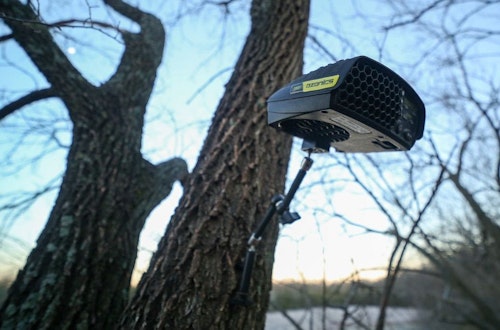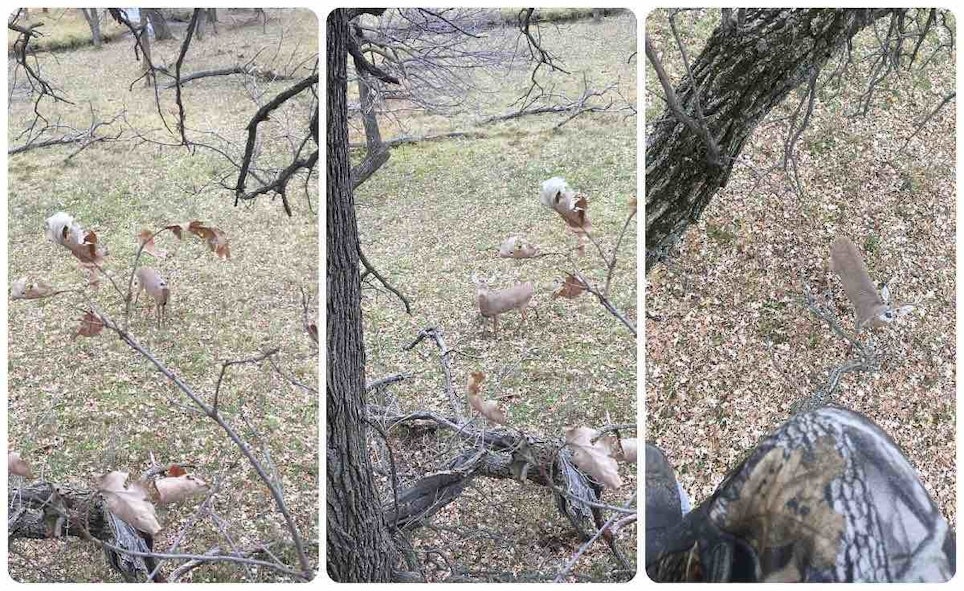
The author’s DSD buck decoy is facing his treestand, while his Flambeau doe decoy is facing away. This combo mimics a buck tending a hot doe, which can drive cruising bucks crazy.
Avid whitetail bowhunters improve each season because they learn from their successes and failures. Deer win the daily chess match almost every time. It’s not easy to fool a whitetail’s incredible sense of smell, as well as its finely tuned vision and hearing.
During the past decade of pursuing whitetails, I’ve learned that one particular combination is deadly for luring rutting bucks into shooting range. My system relies on using a decoy, treestand and ozone generator. Each component is important; subtract any one of them and my chance of success drops dramatically.
Decoy
My system begins with a deer decoy. Brand and model isn’t critical, but I’ve certainly had the best success with three versions: Flambeau Regal Whitetail Doe, Montana Decoy Trixie Whitetail Doe Decoy, and DSD Posturing Buck.
The Flambeau Regal Whitetail is a realistic 3-D doe decoy that stands up well in light to moderate winds (no stakes needed), and when the wind is really howling, I find a heavy branch on the ground and then simply lean it over the decoy’s back to pin it to the ground (the decoy looks very natural this way).
The Trixie Whitetail Doe from Montana Decoy Co. is a great-looking 2-D decoy that weighs next to nothing and folds flat, so it’s ideal for long hikes onto public land or Walk-In properties. Many times I’ve had bucks circle the Trixie, and they don’t seem to care that it’s not three dimensional.
When I can drive my ATV or pickup to a stand site prior to hunting, I rely on my DSD Posturing Buck. Nothing on the market looks as real as this ready-to-fight buck decoy. It weighs 35 pounds and has the dimensions of a mature whitetail. It comes with a podium base that holds the buck upright regardless of wind or frozen ground.
Treestand
I’ve killed a few deer over a decoy from the ground, but in most instances it’s better to be in a treestand. Whitetails almost always try to get downwind of a decoy before approaching it, and many times this means they walk downwind of you, too. On the ground, they bust you almost every time if they circle downwind of your ambush position.
I rely on hang-on portable treestands or ladder stands, then position a decoy 20 to 25 yards away. Bucks will approach a buck decoy head on, and they approach a doe decoy from the rear, so set the decoy’s angle accordingly. Because shots are close — 5 to 15 yards typically — I don’t like being too high in a treestand; it’s impossible for my arrow to penetrate both lungs if the angle is too severe. Usually I’m 14 or 15 feet off the ground.

Ozone Generator
As stated earlier, whitetails often circle downwind of a deer decoy, which means they can circle downwind of you, too. One of my favorite decoying spots is a river-bottom in South Dakota; it has numerous large trees, but it’s very open because cattle live there during summer and early fall. The open terrain is great for decoying, but it’s common for whitetails to circle my treestand regardless of wind direction and decoy position.
During the past five years, I’ve carried an Ozonics device to the treestand. I attach it to the tree about a foot above my head when I’m standing. Initially I was highly skeptical about whether it would make a difference, but after many hunts through the years, I’m a believer.
When whitetails — including mature bucks — walk downwind of my treestand, they stop and then raise their nose. They smell the ozone. But then they lower their heads and stare at the decoy. Do they smell me, too? Maybe. But the ozone must kill or mask enough of my human odor that they appear confused. It’s like they know they should run, but if another deer — the decoy! — is okay with the smell, then it must be safe.

On many days, the combination of a decoy, treestand and ozone generator almost feels like cheating. Almost. Even with all these advantages, however, whitetails still win 99 percent of the time, and I wouldn’t want it any other way.






